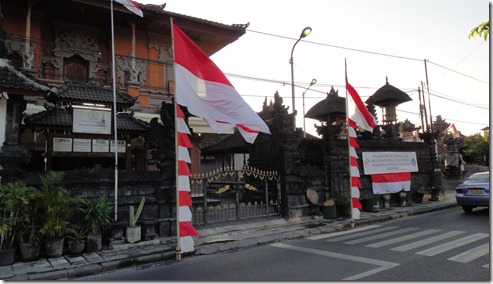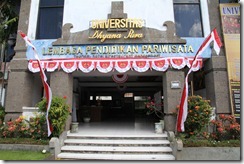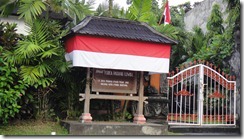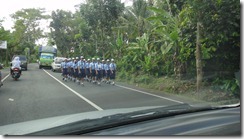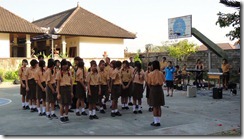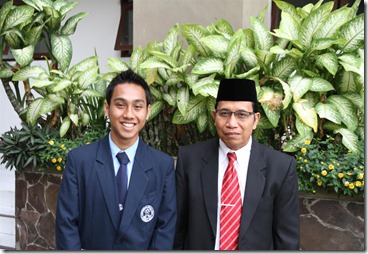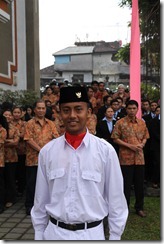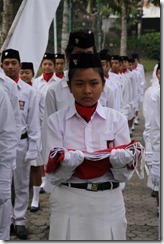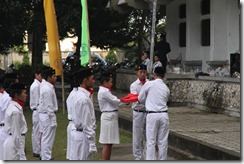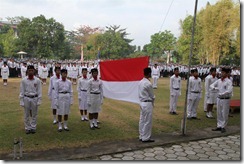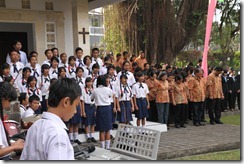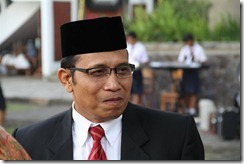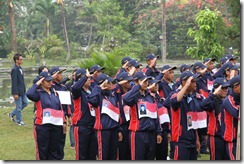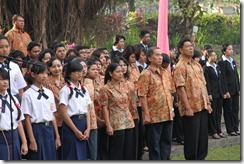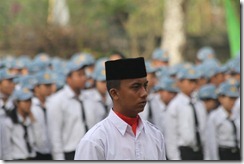“Here be dragons” – reputedly what early map makers would write in the unknown and unmapped territory when they produced their charts. Last week I went in search of the “Komodo Dragon”, survivors from an ancient time.
Christine, the very efficient campus facilities manager, was able to secure a place on a short 3 day / 2 night Komodo Adventure Tour. I was picked up from campus on Saturday morning (25 Aug) and taken to the airport, collecting the other 2 guests along the way. My fellow travellers were Anna and Luigi from Bologna, Italy. After about an hour’s wait we boarded our Fokker F50 (Sky Air, PK-ECF) for the 90 minute flight east to the town of Labuan Bajo on Flores, one of the larger islands of the Lesser Sunda Islands group. The views on approach confirmed the description in the guide books – the island is both mountainous and dry. Across many of these islands rain only falls on average during 4 months of the year. We were to see more dry landscapes over the next 2 days.
 |
The Sky Airways Fokker F50,
PK-EFC, bound for Flores |
As you leave the plane and walk to the small terminal building you can’t miss the sign which displays the reason for most of the arrivals.
 |
Airport sign with dragon welcoming
visitors to Labuan Bajo |
The small town of Labuan Bajo is an important transport hub in this part of the Indonesian Archipelago. Flights (and boats) go east as far as Papua and west to Bali and Jakarta. It has grown in importance as the gateway to the Komodo National Park and the fine cruising waters amongst the many islands. We were met on arrival by our driver and Iren our local tour host. He was very much like my friend Hans Mbot in Bali. Hans is also from Flores, and he and Iren had exactly the same style of speaking English suggesting that there is a specific school of English taught in Flores. Hans' surname "Mbot" starts with the "MB" which I've only seen in Flores names. Iren was a friendly, competent and very considerate host for the trip.
 |
| Labuan Bajo streetscape - beside the seawall |
After a short stop to rent swim fins we reached the dock and “marina” area where we imagined which of the many boats we would board. It was a little like the Goldilocks story … that one’s too small, that one’s too big, but THIS one is about right”.
 |
| Local boats - those are too small |
 |
| That one's too big! |
 |
| This one's about right - it's our boat |
Our boat was typical of several small tour boats we saw in the waters around the Komodo park. We boarded and the long narrow boat pulled away from the pier and we headed out into the bay for the long haul to our first landfall at Loh Buaya on Rinca Island. The crew prepared lunch to eat along the way and we arrived just before 3 after a trip of about 2½ hours.
 |
| Setting off (L-R): Iren, Anna and Luigi |
 |
| Our captain in the "wheelhouse" |
Rinca is one of 3 larger (and 26 small) islands contained in the Komodo National Park which covers 1733 square kilometres (approximately 600 sq km is land and the balance is the surrounding sea). The Park was established in 1980 to protect the Komodo dragon and protection was later extended to cover other species. In 1986 ( some sources say 1991) the national park was declared a UNESCO World Heritage Site and later a “Man and Biosphere Reserve”. It has been listeed as one of the “New 7 Wonders of Nature”.
 |
| Jetty, "gateway" and sign at Loh Buaya, Rinca Island |
Although the dragon is the most famous attraction in the park, and the main reason for its declaration, the islands also contain unusual savannah vegetation because of the hot and dry climate, and a variety of Asian mammals. The waters have extensive coral reefs and are rich in marine life including whale sharks, ocean sunfish, manta rays, eagle rays, pygmy seahorse, false pipefish, nudibranchs, blue-ringed octopus, sponges and corals (source: Wikipedia - Komodo National Park).
At the end of the short jetty was a sign announcing the park where we were met by a park ranger who gave us a few safety “dos and don’ts”. Falling in line behind the ranger armed with his two metre forked stick (not all that reassuring, but in general the dragons don’t bother people who are careful!) we set off and immediately encountered a dozen dragons asleep around the base of the kitchen at the rangers’ station. They are attracted by the cooking smells even if they are not actively in search of food (and anyway, feeding is prohibited). The rangers buildings are up on stilts – both for cooling and for protection from dragons.
 |
| Dragons lazing around beside the kitchen |
We approached to within about 10 metres to observe the large animals and could immediately see why local people and early investigators referred to them as “land crocodiles”. There was an undeniable similarity. The Komodo dragon grows to about 3 metres in length (largest recorded was 3.13m) and about 70kg in weight. It can see to about 300 metres but has poor night vision; its hearing abilities are limited, but it has an exceptional sense of smell, able to detect carrion as far away as 9 km under favourable circumstances. Like some snakes, they sample the air by flicking the tongue about and then withdrawing it into the Jacobson organ in the mouth to taste/smell/sense potential prey and food. They can sprint in short bursts at 20km/h, swim short distances, dive to 4 metres, and climb trees when young and small.
 |
| Dragon smells the air with its tongue |
The Komodo dragon harks back to the days of the giant reptiles which lived across Australia and Indonesia, and recent skeletal finds in Queensland suggest that the dragon originated in Australia (in the days of the giant kangaroos and wombats), spread to Indonesia and then died out in Australia. The large monitor lizard is the surviving Australian representative of that type of animal.
There are an estimated 4000-5000 dragons spread across 5 islands in this group (not all within the park) but possibly only 350 of these are breeding females. The species is listed as “vulnerable”, but they could become “endangered” if the number of breeding females declines.
 |
| A male palm tree |
 |
| A female palm tree |
The guide pointed out the difference between the female and the male palm tree - "nuts" (the female has them). The male has bunches of curly fronds and the male is used for "arak", the local strong spirit.
 |
| The male has these curly fronds |
After about 15 minutes walk into the savannah vegetation (keeping a careful lookout) we spotted the first dragon on the move. I felt conflicting urges – to get closer for a better view and at the same time to keep my distance from these large and powerful animals.
 |
| A dragon on the move |
In the vegetation we saw many examples of the dragon’s prey: bush fowl, macaque monkeys, deer, a buffalo (clearly just one of many judging by the distribution of dung). Small ponies are also a significant part of the diet.
 |
A buffalo in the vegetation;
a good meal for dragons |
Our guide explained that most of the mating activity was over and that females would soon start to lay eggs. The “nests” are usually enlarged holes in the nesting mound of the megapode bird (a type of scrub fowl) into which the female deposits about 20 eggs. The female often makes a false nest near the eggs to confuse predators. The eggs incubate for 7-8 months and usually hatch in April when abundant insects provide plentiful food for the young dragons. The babies soon take to the trees where they live in cavities for 2 or 3 years as protection from larger dragons.
 |
| A female on a nesting mound |
After about 1½ hours on Rinca Island we boarded our boat and motored for over 2 hours through rising seas and wind blown spray to Komodo Island where at 7 pm we anchored in a small bay not far from Pink Beach. The sunset was spectacular but brief.
 |
Sunset on the way to Pink Beach. No
filters or tricks, the sky was that colour. |
No sooner had we anchored when 3 boats arriving bearing men offering carved dragons ranging in size from a few cm to half a metre and pearls of various colours (off white, pale brown, and green-black). The crew prepared and served dinner by lantern light and at 9 am we turned in after a long day.
 |
| Top deck bedding - that's my bed at the rear |
Whilst sleeping under an awning on the deck of a local boat looked attractive in the brochure, the reality was different. The evening was cool but when the wind came up at about midnight the boat developed quite a rocking motion. At about 4:30 am the skipper started the diesel engine and started pumping water (to stop us sinking?) and further sleep was difficult because of the noise and vibration. Sunday morning was cool and very cloudy with some sea mists obscuring the hills behind the shore line.
After breakfast we motored a couple of kilometres to the park entrance at Loh Liang, picked up a guide, received our warnings and set off on the long walk. My suspicions were justified – the long walk had a lot of very little as most of the attractions were at the ends and we could have saved an hour and some effort by taking the medium walk – but time was something we had plenty of. Dragons were lolling about the kitchen and amenities areas but we also saw a couple out on the trails, along with deer and a wild boar. In the trees we saw 2 baby monitors – one with head poking out of the hole, and another resting on a branch.
 |
A dragon on Komodo Island; only its
mother could love a face like that! |
 |
| Wild boar - another favourite food |
 |
| A young dragon safely up in a tree |
At about 9:15 we were back on board and motoring back to Pink Beach (Pantai Merah) for a swim and opportunity to snorkel in the shallow clear waters. Brightly coloured fish swam amongst the many types of coral. The coral was not as large and diverse as I’ve seen on the Great Barrier Reef (a tough act to beat) but was interesting to observe. Most fish were small but I did see a couple of large fish, possible wrasse, and a pipe fish over half a metre long.
 |
| Our boat - snorkel view! |
 |
| Brightly coloured fish |
 |
| It had been a long day for our tour guide |
By now the sun was intense and despite applying some cream and not being in the sun for long I sustained some sunburn which became evident that evening when I showered. Two young boys in a small rotten log canoe tried peddling carvings and pearls but we declined. A few other boats came to the same beach site. Lunch was served at the moorings before we set off at about 1 for the 3+ hours back to the pier at Labuan Bajo.
On the return trip we saw several small local fishing boats and also some large sailing boats which make the inter-island trip to and from Bali and beyond. My favourite was a blue schooner which raced towards then past us – she had beautiful lines and a wonderful rake to her masts.
 |
What a beautiful and racy schooner
- what a pity it wasn't our boat |
At 4:30 we reached the port at Labuan Bajo where we moored amidst small cargo boats, ferries and fishing boats. Our car was waiting beyond the dock area and we were soon checking in to the Central Bajo Hotel. The shower (cold of course, as only “deluxe” and “VIP” rooms had hot water) was much needed but it caused the sunburn to sting. At sunset I followed the rough path up the hill to a lookout with wonderful “sunset views”. The location and view was splendid, but there was no sunset because of thick cloud. I’m glad I took my torch as the path down was indistinct and a little dangerous.
 |
Poor sunset but great view from
the lookout at Labuan Bajo |
Dinner was included in the trip so we ate at 7 and very soon thereafter went to bed exhausted. Sleep was difficult because it seemed as if the adjacent road was the drag strip for the local motor bike riders, and that mufflers were not working properly.
After breakfast Iren collected us for our “city sights” tour, not that there was a great deal to see. We declined the opportunity to wander around the local market as it looked just like many others we had seen. We were taken to a park site with some limestone caves. The caves were “dead” in as much as they had been open and dry for a long time, and water was no longer laying down new deposits. Long ago in the past some areas had collapsed and we had to squeeze between fallen rocks and through small openings. Probably the most interesting features were the fossilised turtle (quite distinct), a crystallised stalagmite which glistened in the torch light and a large deposit high up on the wall which looked like a Mother Mary apparition.
 |
| Fossilised turtle in the rocks |
 |
| The "Mary" of the rocks |
 |
Watch out for the hand rail - splinters,
not attached at the top end, and the
support has pulled loose. OHS is not a
big issue here. Just take personal care. |
From the caves we went to the airport and after a drink and snack checked in. I presented the email confirmation of our flight and was issued with a boarding pass. The whole procedure was handled manually, no ID was checked and baggage was not checked either. Whilst waiting for the flight I had an interesting conversation with an Indonesian man who was a regular traveller and a young French archaeologist from Lyon who had been getting experience at a dig site near the town.
The plane arrived a little late (same as on Saturday) but we boarded quickly and took off on time. Although there was much cloud about, we had good views for about half the flight back to Bali where we landed at about 1:30. On exiting the terminal we were met by “Fritz” the travel representative and driven home - to Sanur first for Anna and Luigi, and then through busy traffic to Dalung.
So I have seen the dragons. I don’t really have a “bucket list” but if I did keep one, that would be one item to cross off. Back in my room on campus the airconditioning, warm shower and bed were most welcome. Clearly I have become old and soft, but never mind. I can still class this trip as an “adventure”.
Paul in Bali
August 2012
































